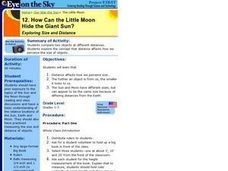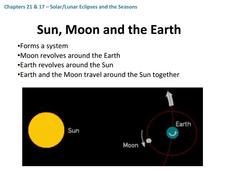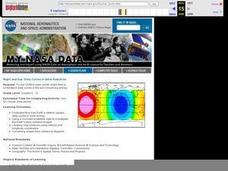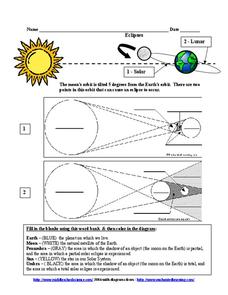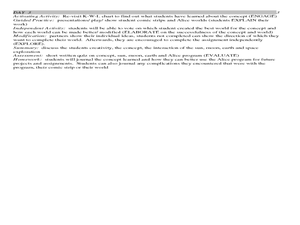Curated OER
How Can the Little Moon Hide the Giant Sun? Exploring Size and Distance
Students compare two objects at different distances. They explore the concept that distance affects how we perceive the size of objects.
Curated OER
An Introduction to the Night Sky and Movement Astronomy
Basically, this is an interactive exploration of educational astronomy software and an app. Young astronomers discover how the apparent motion of the sky relates to Earth's movements and the position of the observer. It is out of this...
Curated OER
How Do Eclipses Occur?
In this eclipses worksheet, students write in the 4 steps explaining how an eclipse occurs. This worksheet is a graphic organizer.
Curated OER
Solar/Lunar Eclipses and the Seasons
How do the moon, sun, and Earth line up to create eclipses? Why do the seasons change throughout a year? The answers to these questions are explained through this series of slides. This apt presentation outlines information using bullet...
PBS
Experience a Solar Eclipse
Didn't catch the last solar eclipse? Now every day can be eclipse day, thanks to an interactive instructional activity from PBS' Space series for middle schoolers! The well-rounded multi-media experience includes video clips, an...
Curated OER
NIGHT AND DAY: DAILY CYCLES IN SOLAR RADIATION
Students examine how Earth's rotation causes daily cycles in solar energy using a microset of satellite data to investigate the Earth's daily radiation budget and locating map locations using latitude and longitude coordinates.
Curated OER
Eclipses
In this eclipses worksheet, students are given diagrams of a solar and lunar eclipse. They fill in each diagram with given terms and color the diagram to indicate the process for each type of eclipse.
Curated OER
Space Science
Eighth graders study the objects in our solar system. In this space instructional activity students identify and describe planets, then classify them as terrestrial or gaseous.
Curated OER
The Tides of Change Worksheet (Part 2)
In this tides worksheet, students visit specified websites to view information. They explore the mass of the sun and moon, the force of gravity between two objects, and the ratio of the distances from the earth to the sun. Students...
Curated OER
Season's Greetings
Students explore Earth's seasons using an interactive website. In this earth science lesson, students watch video segments and explain Earth's seasonal milestones. They discuss the factors that causes seasonal changes.
Curated OER
Facts and Myths about our Solar System
Sixth graders explore popular ideas about the Sun and Moon. In this space science lesson, 6th graders separate commonly accepted details about our solar system into facts and myths. Students research a particular idea and...
Curated OER
Lunar Lollipops
Demonstrate the lunar cycle to youngsters using flashlights and lollipops. The procedure is somewhat vague, so it will need to be modeled for them before turning them loose to try it. The questions that follow the activity are not...
Curated OER
Investigation 3 - What is Moonlight?
Third graders observe a demonstration explaining that the moon reflects sunlight in ordr to shine.
Curated OER
Stellar Lunar Curriculum
Students engage in a lesson about the moon and three different constellations. They conduct research using a variety of resources. The teacher leads the class with demonstrations and discussion groups. The research is also guided using...
Curated OER
Universal Gravity and Kelper's Laws Worksheet
High school physicists apply their knowledge of planetary motion. Using Kepler's three laws, Newton's law of universal gravitation, and the provided properties of the moon, sun, and Earth, they proceed to solve 23 problems. An...
Columbus City Schools
Experiencing Eclipses
Don't be caught in the dark! Young scientists investigate the causes of both solar and lunar eclipses using an interactive to help them understand the development of an eclipse over time. They then research facts and characteristics...
Curated OER
Comprehension: Compare and Contrast Topics in Two Texts
A scripted instructional activity can be a big help for new teachers. This fully scripted three-day learning activity provides teachers with the means to demonstrate how to compare and contrast two topics in two texts. Learners will work...
TLS Books
Neptune
Did you know that Neptune is named after the Roman god of the sea? Young astronomers read about this and other facts about the eighth planet from the sun in a short informational text passage.
Curated OER
The Solar System and Beyond
What an inspiring PowerPoint! The color scheme and pictures all contribute to the scientific style of this PowerPoint and will keep the attention of your junior high kids. The diagrams help illustrate the positioning of the moon, sun and...
University of Colorado
Space Travel Guide
Neptune takes 164.8 Earth years to travel around the sun. In the fifth of 22 lessons, young scientists create a travel guide to a planet in our solar system. They provide tips for others on what to bring, what they see, and their...
American Museum of Natural History
What is Marine Biology?
A marine environment covers the majority of the earth but is arguably the least understood. Teach young scientists about the characteristics of oceans and ocean species using an interactive online lesson. The in-person or remote learning...
K5 Learning
Why Does the Ocean have Waves?
Six short answer questions challenge scholars to show what they know after reading an informational text that examines waves—what they are, what causes them, and how different Earth factors affect their size and strength.
Curated OER
Bouncing Sunlight
Third graders use flashlights and balls to demonstrate how the light bounces off of the sun and reflects onto the moon. They record their observations in a journal.
Curated OER
The Path of the Sun, the Ecliptic
Students are introduced to the ecliptic, the zodiac and the apparent motions of the Sun, Moon and planets across the sky.
Other popular searches
- Earth Moon Sun System
- Earth Sun and Moon
- Earth/sun/moon
- Sun Moon Earth
- Earth, Sun and Moon
- Rubric Sun Moon Earth
- Sun, Earth and Moon
- Sun Earth Moon System
